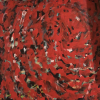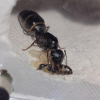So, I've been watching my T. immigrans more closely lately, now that they're getting into the couple hundreds in colony size, and it's easy to observe their various activities. I feed them a range of bugs, mealworms included, and in the past I've noticed them consume the soft insides, and then discard the chitinous exoskeletons like all of my other ants do.
However, lately I've noticed something curious: absent an abundance of other proteins sources (such as when I run out of feeder insects and haven't gotten to the store yet) they seem to keep the small exoskeletons around. There are usually several ants attending to them in some way at any given time. They are gradually broken down, and, evidently, fed to the larvae (here and there I'll notice a fragment placed on the abdomen of a resting larvae in the typical manner for consumption). The fragments, to whatever extent they do appear in waste piles later, seem to be much reduced in cumulative volume, though I suppose I could be misjudging.
I wasn't aware that ant larvae could digest densely chitinous food sources, but the gradual consumption of the exoskeletons and the fact that the workers treat them consistently as some kind of food source, seems to possibly suggest otherwise. However, I read this blog post by an entomologist, who seems to suggest that the typical ant larva can't. So, I was curious if anyone knew more about what they can and can't digest.
















